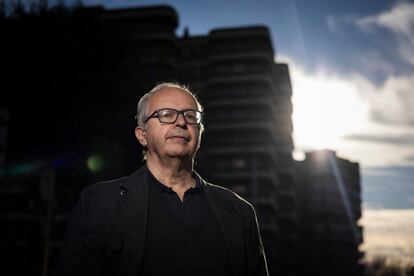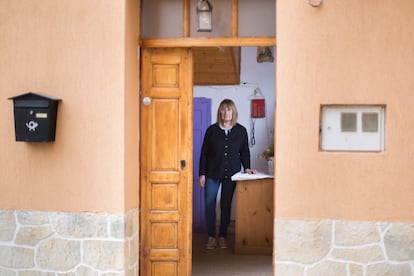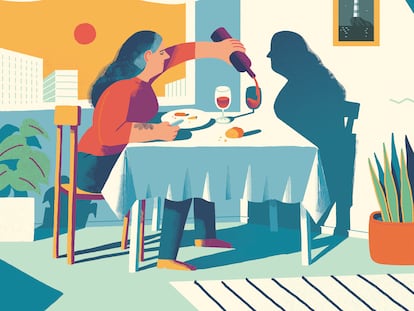The toxicity of living in cities, a risk for mental health
While urban environment may trigger psychological problems, rural areas can also negatively impact a person’s well-being

At the age of 14, Elena Briongos left Peñalba de Castro, a small town in the Spanish province of Burgos, to study in Barcelona. “When I was 18, I was studying and working as a secretary, living what could have been a late adolescence, searching for myself,” says Briongos, who is now 61 years old. “Then I went to a week-long event in which there was a mindfulness workshop, alternative therapies, yoga, dance, a series of things that helped me find myself,” she remembers. “But then I couldn’t control returning back to normal life and that’s where it all started.” She was first diagnosed with schizophrenia, which years later was changed to bipolar disorder, and she began a pilgrimage to specialists in Madrid and Barcelona. “I returned to my village with my parents, farmers.”
Briongos believes that the city offers many possibilities, but it’s in small towns where you really find yourself. After seven hospital admissions, the last one in 2003, she now feels strong. As president of the Mental Health Federation in the Spanish region of Castilla y León, she helps other people with problems similar to hers. In the town of Aranda de Duero, they have three psychiatrists and have created a headquarters in Huerta del Rey, a larger town in the area, where they bring together people from smaller villages to take part in group activities. “When you go with a person to have coffee and they know you, there is no distance or stigma, that’s the advantage of small towns. And if something happens to you, someone will come to your house,” she points out. “But it is also more difficult to break the stigma of a diagnosis, because everyone knows who you are.”
But big cities also have a lot of charm. Albert Einstein revolutionized physics from Bern, Aretha Franklin was discovered in a church in Detroit and the Spanish Constitution was negotiated in Madrid. It is estimated that, in the next decade, the population of cities with more than 10 million inhabitants will increase fourfold, and by 2050, 68% of humanity will live in cities.
But the benefits of cities do not reach everyone equally. A recent study concluded that elite city dwellers enjoy most of the benefits of big cities, while others are left out. In addition to inequality, cities also come with another risk: poor mental health.
Epidemiological studies generally show that mental health is worse in cities than in rural areas. “There are more affective disorders, anxiety disorders, but above all serious disorders, such as schizophrenia,” says Jordi Alonso, director of the Epidemiology and Public Health Program at the Hospital del Mar, in Barcelona. “We found no differences in the use of alcohol or other substances and, in general, when adjusted for socioeconomic factors, there are no differences,” he adds.
To explain this urban toxicity, researchers usually point to inequality, marginalization, stress and violence, which are more common in cities. In the rural environment, social cohesion, which in some cases can be oppressive, is an advantage, just like the proximity of the countryside and the lower levels of air and noise pollution.
A 2020 study, led by Lydia Krabbendam, from the Free University of Amsterdam, put forward an evolutionary hypothesis. It arued that humans, after hundreds of thousands of years of evolution in communion with nature, feel out of place in artificial environments where there are only animals of their species. The need for directed attention wears down cognitive abilities, which need contact with the natural environment to recover. Compared to the past, when our ancestors lived in close-knitted groups, the city of today is full of strangers.
Jim van Os, one of the authors of the study, explains that element in the city can be both a threat to mental health, and supportive, depending on the person. “Being different is very bad for mental health, because we need to feel connected to others. [...] Our whole biology is developed by being linked to others and, during the first 10 years of life, you have a bonding process that guides you in social relationships and with yourself throughout life.” But being different can mean different things in different environments. A gay person may feel more isolated in a village than in a city, and perhaps the opposite is true for person from a village in Senegal who goes to Paris.
Interacting factors
Ángel Urbina, 57, who was diagnosed with a serious mental illness when he was at university, sees drawbacks to city living, as well as advantages. He lives in the city of Tarragona, and as president of La Muralla, an association that is part of Catalonia’s Mental Health Federation, he organizes meetings that are also attended by people from nearby towns. “They have to take a bus and I can walk, and it’s the same with health services,” he points out.
However, when he’s feeling worse, crowds and noise can be problemative. “When I have problems, I need peace, I look for a park or go to the beach. Contact with people makes me feel bad and that happens to many people, you become very sensitive to contact with people and stress,” he adds. Urbina is also not sure that there is less social cohesion in cities. “In a city, if you are very unwell, it’s possible that no one will know, and you may even die alone at home, but we also do not suffer from the stigma from the old mentalities of places where everyone knows you. Here you can enter a bar and no one will think that you are the town’s crazy person,” he explains.
In 1939, Robert Faris and Warren Dunham published a study on mental disorders in Chicago. That pioneering work observed that the higher the population density of the neighborhoods and the higher the proportion of black population, the higher the number of schizophrenia cases. “It was not clear which component of urban life increased the risk, but for many decades it was accepted that this was the case,” says Gonzalo Martínez Alés, a psychiatrist at the Harvard School of Public Health. “There was a moralistic interpretation, which identified the city with vice and the rural area with being more bucolic,” he explains. But then, starting in the 1990s, studies in China found that schizophrenia was more common in rural areas, and seemingly contradictory results continued to appear around the world. Maybe it wasn’t about the city, but about poverty; or perhaps there were populations more prone to these diseases that in the city were exposed to circumstances that triggered the latent disorder.
“We have evidence that the increased risk of schizophrenia among immigrant groups in London is inversely proportional to group size. That is, the smaller the group of immigrants, the greater the additional risk of schizophrenia,” explains Guillermo Lahera, professor of Psychiatry at the University of Alcalá in Spain. Among migrants, it has been seen that people who try to integrate into the new culture suffer more than those who mainly interact with the people from their own — with a network that gives them the feeling that they are still part of the majority despite being far from home. Lahera points out that these results “have urban planning and social organization implications,” and proposes trying “to reduce isolated ghettos of ethnic minorities and favoring multicultural social cohesion over fragmentation.”
This type of urban planning that takes mental health into account is already happening, at least on paper. Ester Higueras, a specialist in healthy urban planning at the Polytechnic University of Madrid, points out that “there is a direct relationship between the perception of greenery and well-being.” “Even people who see green spaces through their windows in hospitals recover faster,” she adds. Higueras is one of the authors of the report City, Urban Planning and Health commissioned by the Spanish government. This report offers guidelines on how to create environments that are more conducive to health, including mental health. In addition to facilitating access to green spaces, the study emphasize the need to create environments where people can socialize or that are protected from noise. A study in Madrid estimated that lowering traffic noise by one decibel would prevent 468 premature deaths per year. The stress associated with noise increases the risk of atherosclerosis as well as psychological problems.
Downsides to rural areas
Although cities appear to pose a greater threat to mental health, Higueras points out that rural areas don’t have it easy either. “In the city, there is a lack of green areas, but in the countryside, they have green areas, and their life is not happy and perfect either. There are nuances that we have to study,” she points out. “In villages, there may be a shortage of places where people can come together. The town bar is very important, we are social beings.”
Higuers also points out that “in rural areas, there tend to be more suicides.” Martínez Alés believes that this may be due, among other things, to the fact that suicide depends a lot on whether one has the means to take their own life. “In rural environments there is usually more access to weapons or pesticides, and there may also be isolation factors,” he says
As in other areas of medicine, mental health is looking to provide personalized treatments. “There are people especially vulnerable to developing mental disorders, but not all of them develop them. On the other hand, there are proven risk factors, but not all people exposed to these risk factors develop the disease,” explains Lahera. To better understand the crossover between genetics and the environment, researchers are studying the biological mechanisms by which pollution or poverty can increase the risk of depression or schizophrenia. In a study published in 2023 in Nature Medicine, it was observed that an uncrowded environment with green spaces protects against anxiety symptoms.

“It’s common sense, but this data-driven result provides more specificity and concerns brain areas and genetic susceptibility to this common sense observation,” says Gunter Schumann, co-author of the study and director of the Center for Population Neuroscience and Precision Medicine. This center is dedicated to identifying the relationships between genetics and environment that can help minimize people’s individual risks, regardless of where they live. Some studies have observed that cities have risk factors for children during the first 15 years of life, and projects such as environMENTAL, led by Schumann, aim to better understand these dangers to intervene ahead of time and stop them.
Although mental health is generally worse in cities than in towns, Schumann believes that it’s not a useful object of study as “many people have no choice” about where they leave. He argues it is more useful to provide data that scientifically confirms how pollution and noise can impact the mental health of teenagers, and how loneliness affects the elderly, and then use that evidence to push the local government to enact changes.
People with mental health problems know that there is room for improvement in both rural and urban environments. Briongos wants people in small towns and villages to be given greater access to medical treatment. Urbina highlights the importance of facilitating social interactions: “The most important thing in mental health is community, for people to feel part of their society. One of the most serious mental health problems is social isolation, that people ignore you.”
Sign up for our weekly newsletter to get more English-language news coverage from EL PAÍS USA Edition
Tu suscripción se está usando en otro dispositivo
¿Quieres añadir otro usuario a tu suscripción?
Si continúas leyendo en este dispositivo, no se podrá leer en el otro.
FlechaTu suscripción se está usando en otro dispositivo y solo puedes acceder a EL PAÍS desde un dispositivo a la vez.
Si quieres compartir tu cuenta, cambia tu suscripción a la modalidad Premium, así podrás añadir otro usuario. Cada uno accederá con su propia cuenta de email, lo que os permitirá personalizar vuestra experiencia en EL PAÍS.
¿Tienes una suscripción de empresa? Accede aquí para contratar más cuentas.
En el caso de no saber quién está usando tu cuenta, te recomendamos cambiar tu contraseña aquí.
Si decides continuar compartiendo tu cuenta, este mensaje se mostrará en tu dispositivo y en el de la otra persona que está usando tu cuenta de forma indefinida, afectando a tu experiencia de lectura. Puedes consultar aquí los términos y condiciones de la suscripción digital.
More information

How to prevent midlife loneliness from getting you down
Últimas noticias
Maduro pleads not guilty before the federal court in New York: ‘I am still the president of Venezuela’
A new test can detect Alzheimer’s from a finger prick
UN team enters Sudanese city of El Fasher after paramilitary massacre: ‘It’s like a ghost town’
A recipe for resistance: Indigenous peoples politicize their struggles from the kitchen
Most viewed
- Gilles Lipovetsky: ‘If you want to live better and fall in love, take Prozac, don’t look to philosophy’
- Alain Aspect, Nobel laureate in physics: ‘Einstein was so smart that he would have had to recognize quantum entanglement’
- Alvin Hellerstein, a 92-year-old judge appointed by Bill Clinton, to preside over Maduro’s trial in New York
- Why oil has been at the center of Venezuela-US conflicts for decades
- Maduro’s downfall puts China’s relationship with Venezuela to the test










































